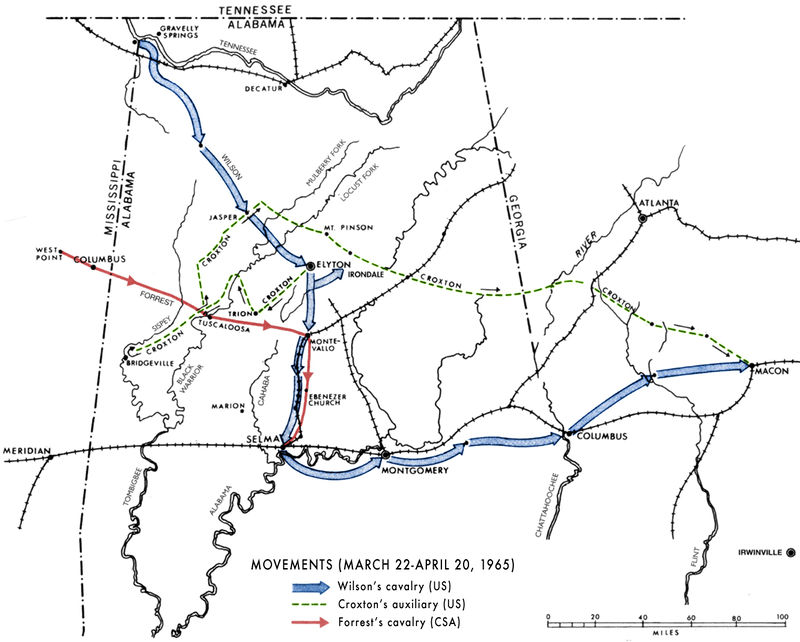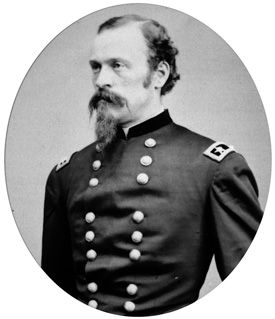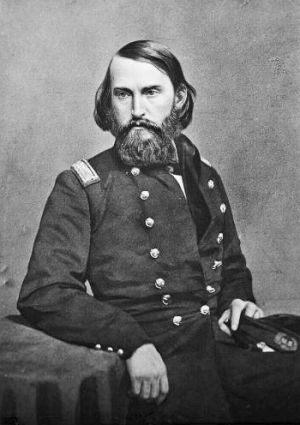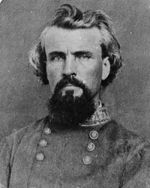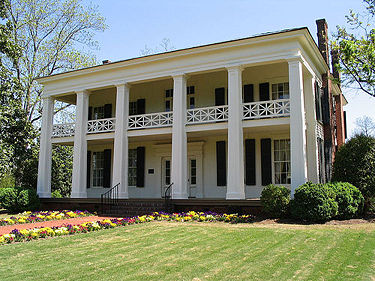Wilson's Raid
Wilson's Raid was a 28-day, 525-mile long cavalry operation through Alabama and Georgia in March-April 1865. It was the Civil War's largest cavalry raid, and final major engagement. Seeking to break Confederate supply lines and hasten the South's surrender, United States Brigadier General James H. Wilson led his Army Cavalry Corps to destroy Southern manufacturing facilities in Alabama and Georgia. His incursion was opposed unsuccessfully by a smaller Confederate force under Lieutenant General Nathan Bedford Forrest. The campaign was successful and curtailed the possibility that Confederate forces might regroup in the west, prolonging Civil War.
Background and opposing forces
By 1865, with the Union navy blockading seaports and the factories of Virginia and Tennessee destroyed or captured, the furnaces in the hills of Alabama were supplying as much as 70% of the iron used by the Confederate war effort. The large blast furnaces at Tannehill, Oxmoor, Irondale and Brierfield together produced as much as 75 tons per day, supplemented by many smaller bloomeries . The Ordnance and Naval Foundry in Selma, manned by a force of nearly 10,000 workers, was one of the last facilities producing cannon, large guns and ammunition.
After his victory at the Battle of Nashville, Union Major General George H. Thomas and his Army of the Cumberland found themselves with virtually no organized military opposition in the heart of the South. At the behest of General Ulysses Grant, Thomas ordered Brig. Gen. James H. Wilson (who commanded the Cavalry Corps of the Military Division of the Mississippi, but was attached to Thomas's army) to lead a raid to destroy the arsenal at Selma, by way of Tuscaloosa, in conjunction with Maj. Gen. Edward Canby's operations against Mobile.
Wilson led approximately 14,000 men in three divisions, commanded by Brig. Gens. Edward M. McCook, Eli Long, and Emory Upton. His corps camped near Gravelly Springs, just north of the Tennessee River in northwest Alabama through the first months of 1865. In addition to 12,000 mounted cavalry men, armed with 7-shot Spencer repeating carbines, Wilson had command of 1,500 foot soldiers with 36 batteries of 12-pound cannons, 58 pontoons for bridge-building, and 60 supply wagons.
With almost the entirety of the Confederate army engaged in North Carolina, Wilson's principal opponent was Lt. Gen. Nathan Bedford Forrest, whose Cavalry Corps of the Department of Alabama, Mississippi, and East Louisiana consisted of about 2,500 troopers organized into two small divisions, led by Brig. Gens. James R. Chalmers and William H. Jackson. The campaign also met resistance from two partial brigades under Brig. Gen. Philip D. Roddey and Colonel Edward Crossland, and a few militia acting as home guards.
Campaign
Wilson was delayed in crossing the rain-swollen Tennessee River, but got underway on March 22, 1865, departing Gravelly Springs, Alabama. He sent his forces in three separate columns to mask his intentions and confuse the enemy; Forrest learned very late in the raid that Selma was the primary target. Minor skirmishes occurred at Houston, Alabama on March 25 and the Black Warrior River on March 26, and Wilson's columns rejoined at Jasper on March 27, burning Jasper Methodist Church, the Walker County Courthouse and the Jasper Masonic Lodge before sweeping the countryside to commandeer provisions from farmsteads.
On March 28 the combined corps marched into Jones Valley. After a brief skirmish at the "miserable little town" of Elyton, the cavalrymen camped along Red Mountain. One group of officers exchanged fire with a small unit of the home guard at the home of Sheriff Abner Killough at the spring in present-day Avondale Park. According to legend, Mrs Killough, who was home alone, suffered a non-fatal shot to the shoulder, shedding the only blood spilled by war in Jefferson County.
Meanwhile, the commanders settled into Elyton's stateliest homes to question the locals and plan raids against other industrial sites. Wilson commandeered "The Grove," the home of Judge William Mudd. Mudd cooperated with the invaders, providing accurate information about the absence of Confederate forces in the area and the presence, in Tuscaloosa, only of sparse militiamen to supplement the meager corps of cadets.
McCook and Upton occupied Williamson Hawkins' active plantation nearby. In a report from Major S. V. Shipman of the 1st Wisconsin Regiment, the 1,000-acre property, still being worked by slave labor, was described as "extensive and prosperous." Its owner, however, was reported to be "cranky and insolent," as he watched the cavalry men pack up his stocks of corn, wheat, bacon and pork. E. N. Gilpin of the 3rd Iowa Cavalry further reported finding a keg of peach brandy in the cellar, which, "was confiscated without delay, lest it might give aid and comfort to the enemy." After the war's end, Hawkins reported direct losses of over $16,600, not including the loss of slaves and the devaluation of his land.
The next day, Upton led his forces to the Red Mountain Ironworks at Oxmoor. They noted evidence of entrenchments and other fortifications along the way, but they were not manned by opposing forces. As they entered the empty industrial sites, they proceeded to set the wood-framed trestles and sheds to the torch, and to detonate explosive charges in the stone furnace itself. After leaving Oxmoor, they moved up Shades Creek to McElwain, in present-day Mountain Brook. Officers of the 4th Iowa Veteran Volunteers encamped at the furnace's commissary while troopers dismantled the tramway from the Helen Bess ore mines on the south slope of Red Mountain.
On March 31, Upton's forces continued their swath of destruction in Shelby County, marching through Montevallo on the way to destroy the Bibb Naval Furnaces and rolling mill at Brierfield, the Shelby Ironworks and mill on Camp Branch Creek, the Helena Rolling Mill on Bucks Creek, and C. B. Churchill's foundry in Columbiana.
Croxton's auxiliary
On the same day, a brigade led by Brig. Gen. John T. Croxton was sent from Elyton toward Tuscaloosa, by way of Jonesboro. He detached a smaller force under Captain William Sutherland to demolish the Roupes Valley Ironworks at Tannehill. In addition to the three furnace stacks, steam-powered blast engine, and materiel stores, Sutherlands troops burned two covered bridges and a grist mill. A sergeant in the 8th Iowa Cavalry reported coming across a group of black women before they reached Tannehill; "one of them addressed me saying, 'What are you all guine to do?' I told her we were going to burn the iron works. She replied I am powerful glad of that for it uses up any amount [of my people] every year."
After leaving Tannehill, Sutherland's troops rejoined Croxton's brigade and continued toward Tuscaloosa, gaining the notice of General Forrest. He sent Brig. Generals James Chalmers and William "Red" Jackson to meet them. Meanwhile Wilson and his main force resumed their march to Selma. As they reached Montevallo on March 31 they met Forrest's vastly outnumbered cavalry. As Wilson's forces overran Forrest's headquarters, they captured documents informing them of Chalmers' and Jackson's movements. Wilson sent McCook to link up with Croxton's brigade at Trion, near the present town of Vance. Meanwhile, Wilson's men destroyed the Alabama & Tennessee River Railroad depot, a hub for pig iron cargoes headed to Selma.
Croxton and McCook's brigades encountered the Confederates under Chalmers and Jackson on April 1. Thirty of Croxton's soldiers were killed and another 30 captured in an indecisive battle which succeeded mainly in forcing Croxton and McCook to take an alternate route to Tuscaloosa. When the Union cavalry reached Tuscaloosa on April 2, they proceeded to destroy the mills, factories and warehouses along the Black Warrior River and to set the small campus of the University of Alabama to the torch.
Wilson continued with the remainder of his force rapidly toward Selma. Forrest made another stand on April 1 at Plantersville, near Ebenezer Church, and was routed once again. The defeated general and his remaining men retreated into Selma to organize its defenses, creating a three-mile long, semicircular line anchored at both ends by the Alabama River and manned by no more than 2,000 mostly untrained defenders.
Battle of Selma
The Battle of Selma took place on April 2. The divisions of Long and Upton assaulted Forrest's hastily constructed works. The dismounted Union troopers broke through by afternoon, after brief periods of hand-to-hand combat; the militia troops abandoning their positions and fleeing were a primary reason for the entire line breaking.
General Wilson personally led a mounted charge of the 4th U.S. Cavalry against an unfinished portion of the line. General Long was severely wounded in the head during the assault. Forrest, who was also wounded, and whose tiny corps was severely damaged, regrouped at Marion, where he finally rejoined with Chalmers. Wilson's men worked for over a week at destroying military facilities before departing for Montgomery, which they occupied on April 12.
Word reached the Union force of the surrender of Robert E. Lee on April 9 and the assassination of Abraham Lincoln on April 14, but the raid continued, heading east into Georgia. The Battle of West Point, Georgia, occurred on April 16 when the brigade of Colonel Oscar H. La Grange attacked an earthwork defensive position named Fort Tyler. Although the Union men had to bridge a ditch under the fire of two 32-pounder guns inside the earthwork, Fort Tyler was captured. Confederate Brig. Gen. Robert C. Tyler, who had originally commanded the garrison at Selma before Forrest recommended that he evacuate the city, was mortally wounded by a sharpshooter, becoming the last general officer to be killed in the Civil War.
Also on April 16, Upton's division clashed with Confederate forces at Columbus, Georgia, capturing the city and its naval works and burning the "cottonclad" ramming ship, CSS Jackson. On April 20, Wilson's men captured Macon, and Wilson's Raid came to an end, only six days prior to General Joseph E. Johnston's surrender of all Confederate troops in the Carolinas, Georgia, and Florida to William Tecumseh Sherman in North Carolina.
Aftermath
Wilson's Raid had been a spectacular success. His men captured five fortified cities, 288 cannons, and 6,820 prisoners, at a cost of 725 Union casualties. Forrest's casualties, from a much smaller force, numbered 1,200. Wilson and his commander, George H. Thomas, did not tolerate uncontrolled behavior, such as looting, from their men. Residents accused Wilson's men of sacking Selma after the battle, but during house-to-house fighting, fires broke out, and renegades from both armies, along with escaping slaves, looted. Wilson quickly re-established discipline.
A sad postscript followed the raid. Union prisoners of war were released from Cahaba Prison near Selma by Wilson's Raid. Over 2,000 of these prisoners would be victims of one of the greatest disasters of the era, the explosion of the steamship Sultana on April 27, 1865.
References
- Eicher, David J. (2001) The Longest Night: A Military History of the Civil War New York:Simon & Schuster ISBN 0684849445
- "Wilson's Raid" (June 5, 2006) Wikipedia - accessed June 5, 2006
- Jones, James Pickett (2015) Yankee Blitzkrieg: Wilson's Raid through Alabama and Georgia. University of Kentucky Press
- National Park Service battle description for Selma
- Alabama state history
- Army of the Cumberland website on Wilson's Raid
